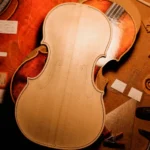Violin Bows: All You Need to Know
Back to BlogOver the centuries, violin bows have been made in a variety of ways by many bow makers. Today, luthiers get inspiration from old master makers to build violins. The skilled craftspeople who create them also use techniques developed by the bow master makers from the past!
Violin Bows
The French bow-making tradition began in the town of Mirecourt, located in the Vosgian mountains. The early French bow makers found that wood brought to France for textile dyeing was just right for making bows.
Many of the finest bow makers of 19th-century Paris were originally from the town of Mirecourt. They later made their way to Paris, bringing with them a new form of the bow that took its final shape in the hands of François Tourte in 19th-century Paris.
The Best Violin Bows
As we know, a good violin bow can bring out the best in your instrument. Actually, it can get another 30 to 40% out of a good violin and bring out ”the voice” of the instrument. A bow emphasizes the overtones in the sound that are very special. As we’ve discussed earlier, the quality of the material used in a bow impacts its ability to play. Wood bows are the best option for a violinist.
When choosing a violin bow, consider both your skill level and playing style. Don’t forget that to achieve your full potential you need an excellent instrument in one hand and an excellent bow in the other!
The perfect match between a musician and a bow is when the bow flows with you as you play. This gives you confidence, allowing you to play with less effort. The bow needs to become an extension of your hand so you can always perform better.
Taking good care of your violin bow is essential.
A violin bow is as important to a violinist as the instrument itself. Without it, you wouldn’t be able to play. Keep your bow in good condition, never tighten its hair too much, and loosen it after each use. Also, wipe the stick clean with a soft cloth to remove rosin dust after each time you play. If you regularly play your violin, have it checked periodically by a luthier.
- Always loosen the bow when not in use. Loosening the hairs of the bow when not playing ensures that it doesn’t lose its camber and prevents the bow from warping over time.
- To avoid a build-up of rosin across the hairs and the wooden section of the bow, you should only use rosin when necessary. Reducing the amount of rosin, you use and how often you apply it will create a cleaner, more pleasing sound.
- Violin bows accumulate dirt from sweaty hands, making it hard to play the instrument well. Students, in particular, have difficulty maintaining the right-hand position if the bow is dirty.
- Do not clean the hair with any product. Over time, you may need to clean your violin bow. When you do it, don’t use any products on the hair as this can damage them and the bow stick.
Looking for a new violin bow?
One very good tip for finding the best violin bow for you is looking for one made by the Lucchi family. They are the legendary family of bow makers from Cremona, whose experience spans years. They have helped many musicians find their ideal bow; let’s see what they have to say to help you.









